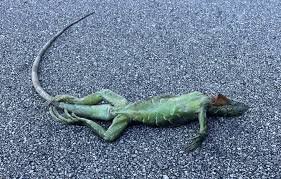Iguanas falling from trees in cold weather has become so common in Florida that it’s even been incorporated into weather forecasts. But why do these reptiles react this way to the cold?
Since they’re cold-blooded, green iguanas (Iguana iguana) can struggle to maintain their body temperature in cold weather, causing them to temporarily fall into a lethargic state. It’s a type of paralysis that can cause them to lose muscle control — so they fall from their perch.
The paralysis usually occurs when the weather drops below 40 degrees Fahrenheit, said Joe Wasilewski, a conservation biologist at the University of Florida. Cold weather also affects other non-native reptiles in Florida, such as pythons and alligators, which often can’t survive when temperatures drop.
Non-native species
The green iguana’s original native range stretches from southern Mexico to central Brazil and Bolivia, so their optimal body temperature is between about 85 and 95 degrees Fahrenheit (29 to 35 degrees Celsius), Vasilevskiy told Live Science.
When temperatures drop below 50 F (10 F), the iguanas’ metabolism slows down, and they start falling from the trees when temperatures reach the low 40s.
“Their body metabolism is made to live in the tropics,” Vasilevskiy said. “They’re used to being in these habitats, for example South Florida … where once or twice a year we get cold snaps.”
Expanding range
This phenomenon has become more noticeable recently because of a boom in the iguana population. Iguanas were introduced to Florida in the 1960s, and their population has grown since the 1990s, partly because of a lack of natural predators.
Wasilewski says the phenomenon of falling iguanas in South Florida is well known because the green iguana population is increasing, but also because Florida is probably the northernmost region of their invasive range — so it’s one of the few places where iguanas mostly thrive, but sometimes have cold weather. However, that could change as temperatures rise due to climate change.
“I’m getting more and more reports of counties north of the northern border where [the iguanas] are starting to show up,” Wasilewski said. “As the weather gets warmer, they’re going to spread themselves out into more northern counties; however, those northern counties are going to get colder than southern Florida, and I don’t think they’re going to survive.”
Usually, paralyzed iguanas come to their senses when temperatures rise, but falling iguanas can become a danger, injuring people or damaging cars. The National Weather Service has issued a fall iguana warning, encouraging people to be aware of their surroundings — and to leave it alone if they come across a cold-stunned iguana.
“FWC’s Nonnative Fish and Wildlife Program staff remind people that if they encounter a cold-stunned iguana, they should not bring it into their home,” Lisa Thompson, a spokeswoman for the Florida Fish and Wildlife Conservation Commission, told Live Science in an email.
“Iguanas are wild animals and once they recover and warm up, they may act defensively.” Wasilewski said he was once called to collect a cold-stunned iguana, moved it into a box when the weather warmed, and later opened the box to find it was full of extremely active and jumpy iguanas.
